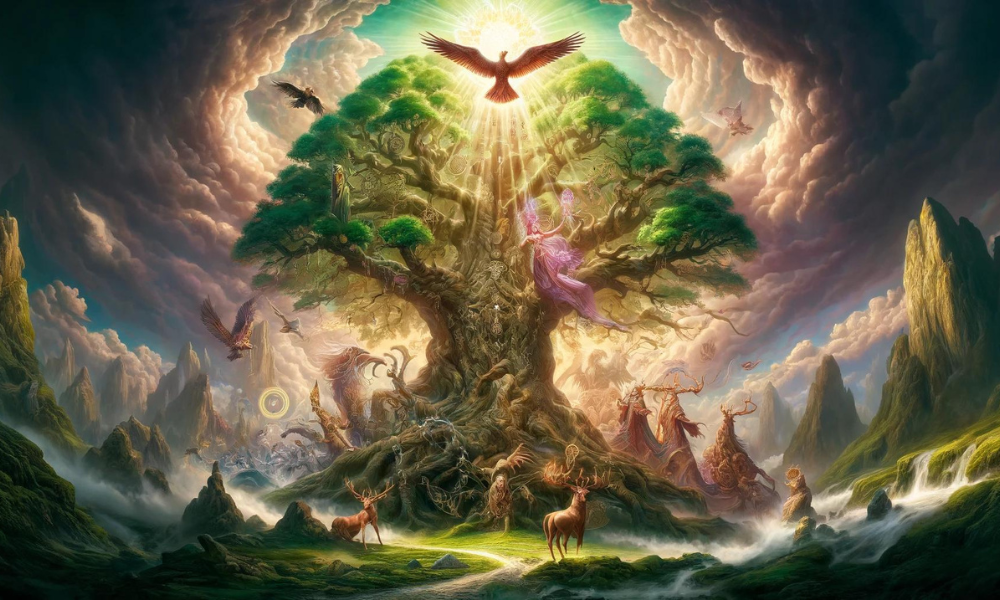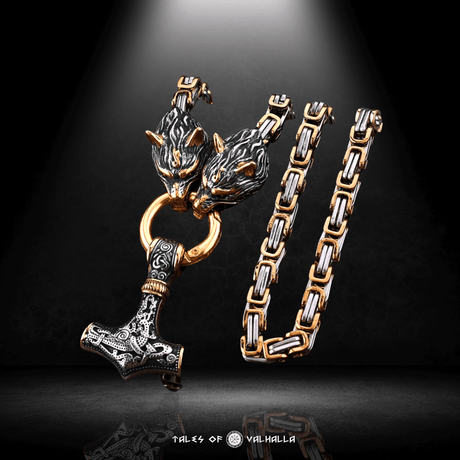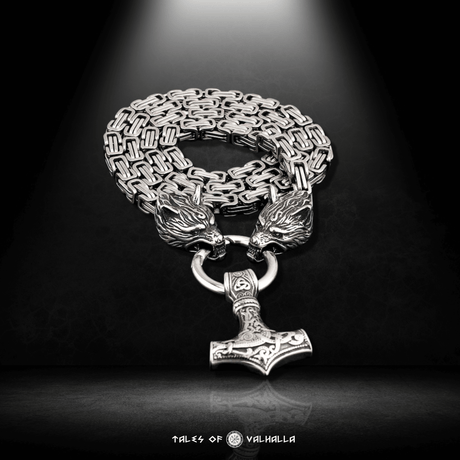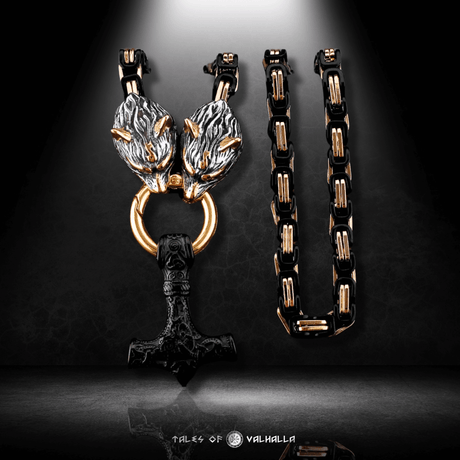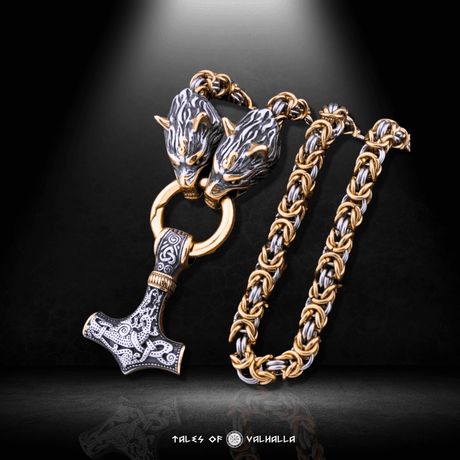In the rich tapestry of Norse mythology, few symbols are as iconic and central as Yggdrasil, the World Tree. This immense, mystical ash tree stands at the heart of the cosmos, connecting all of existence in Norse belief. Yggdrasil is not merely a tree; it is the axis mundi, the axis of the world, holding together the Nine Realms of Norse cosmology and embodying the interconnectedness of all life, death, and the universe.
Yggdrasil's branches stretch out over all of creation, while its roots delve deep into the mysterious and primordial forces that sustain the world. It is a symbol of life, growth, death, and rebirth—a testament to the cyclical nature of existence. From the highest heavens of Asgard, where the gods reside, to the dark, cold depths of Niflheim and Helheim, where the dead dwell, Yggdrasil is the thread that ties the cosmos together.
In this blog, we will explore the profound significance of Yggdrasil in Norse mythology, its connections to the Nine Realms, its role in ancient rituals and beliefs, and its enduring legacy in modern culture and beyond.
The Mythological Significance of Yggdrasil

The Mythological Significance of Yggdrasil
Yggdrasil as the World Tree
Yggdrasil occupies a central place in Norse mythology as the World Tree, a cosmic entity that connects all the realms of existence. It stands at the center of the universe, and its roots and branches extend to every corner of the cosmos. According to the Eddas, the ancient texts that are the primary sources of Norse mythology, Yggdrasil is so vast that its branches cover the sky and its roots reach into the deepest, darkest parts of the earth.
Yggdrasil is more than just a physical tree; it is a symbol of the Norse understanding of the world. It represents the idea that all things are interconnected and that life, death, and rebirth are part of a continuous cycle. This cyclical nature is reflected in the way Yggdrasil is constantly under threat from various forces but never truly destroyed. Even as it suffers from decay, it is also a source of life and renewal.
The Beings Associated with Yggdrasil
Numerous gods, creatures, and entities are associated with Yggdrasil, each contributing to its mythological significance. At the base of the tree, three mighty roots extend into different realms: one into Asgard, the home of the gods; another into Jotunheim, the land of the giants; and the third into Niflheim, the realm of ice and darkness. These roots are nourished by three sacred wells: the Well of Urd, where the Norns (the fates) reside; the Well of Mimir, which grants wisdom; and Hvergelmir, the source of all rivers.
The Norns, who dwell by the Well of Urd, are particularly significant. They are the weavers of fate, determining the destinies of gods and men alike. Every day, they water Yggdrasil's roots with the waters of Urd’s well, which keep the tree alive. This act symbolizes the importance of fate and destiny in Norse belief, with Yggdrasil standing as a testament to the inevitability of time and the interconnectedness of all things.
At the top of Yggdrasil resides an eagle, whose keen eyes watch over the world. Beneath its beak sits a hawk named Vedrfolnir, while at the base of the tree, the dragon Nidhogg gnaws at its roots, representing the forces of decay and destruction. This constant tension between life and death, growth and decay, reflects the balance that Yggdrasil embodies in the Norse cosmos.
The Nine Realms of Yggdrasil
An Overview of the Nine Realms
Yggdrasil is not just a tree; it is a cosmic structure that connects the Nine Realms, each with its own distinct characteristics and inhabitants. These realms represent different aspects of existence and the universe as understood by the Norse people.
-
Asgard: The realm of the Aesir gods, ruled by Odin. It is the highest of the realms and is connected to Midgard (the world of humans) by the Bifrost, a rainbow bridge. Asgard is a place of great beauty and power, where the gods dwell in splendor.
-
Midgard: The realm of humans, located in the center of Yggdrasil’s structure. Midgard is surrounded by a vast ocean and protected by the gods. It is the world as we know it, the middle ground between the divine and the earthly.
-
Vanaheim: The realm of the Vanir, a group of gods associated with fertility, prosperity, and nature. Vanaheim is often depicted as a lush and peaceful land, in contrast to the warlike Asgard.
-
Alfheim: The realm of the Light Elves, who are considered to be benevolent and beautiful beings. Alfheim is a realm of light and beauty, often associated with nature and magic.
-
Jotunheim: The realm of the giants, or Jotnar, who are often in conflict with the gods. Jotunheim is a harsh, rugged land, full of mountains and wild landscapes.
-
Svartalfheim: The realm of the Dwarves, master craftsmen who live underground and create powerful artifacts. Svartalfheim is a dark, mysterious place, associated with both great skill and greed.
-
Niflheim: The realm of ice, cold, and mist, where the primordial forces of the universe originated. Niflheim is one of the oldest realms and is often associated with death and darkness.
-
Muspelheim: The realm of fire, ruled by the fire giant Surtr. Muspelheim is a land of heat and flame, in stark contrast to the icy Niflheim. It is often seen as a place of destruction and chaos.
-
Helheim: The realm of the dead, ruled by the goddess Hel. Helheim is a cold, desolate place where those who die of old age or illness go after death. It is a realm of shadows and silence, far removed from the glory of Valhalla.
Yggdrasil as a Link Between the Realms
Yggdrasil serves as a bridge between these diverse realms, connecting them through its branches and roots. This interconnectedness reflects the Norse belief that all aspects of the universe are linked and that the fate of one realm can affect all the others. The tree's immense size and strength symbolize the enduring nature of these connections, while its constant struggle against decay and destruction reflects the fragility of life and the ever-present threat of chaos.
Yggdrasil’s role as the World Tree also highlights the Norse understanding of the cosmos as a dynamic, ever-changing entity. The Nine Realms are not static; they are constantly interacting with each other, with Yggdrasil at the center of these interactions. This fluidity is a key aspect of Norse cosmology, where the boundaries between life and death, order and chaos, are often blurred.
Yggdrasil in Norse Rituals and Beliefs

Yggdrasil in Norse Rituals and Beliefs
The Tree’s Role in Religious Practices
Yggdrasil was not just a mythological concept; it played a significant role in Norse religious practices and beliefs. The tree was seen as a sacred entity, and its image was often invoked in rituals and ceremonies. It was believed that Yggdrasil could be accessed through sacred groves and trees, where the Norse would gather to worship the gods and make offerings.
In addition to its role in rituals, Yggdrasil was also a symbol of protection and stability. Many Norse people believed that as long as Yggdrasil stood strong, the world would be safe from destruction. This belief was reflected in the numerous stories and poems that emphasized the tree’s resilience in the face of adversity.
The Symbolism of Yggdrasil in Fate and Destiny
Yggdrasil was also closely associated with the concepts of fate and destiny. The Norns, who lived by the Well of Urd at the base of the tree, were the weavers of fate, and their actions directly influenced the course of events in the Nine Realms. The idea that Yggdrasil was nourished by the waters of Urd’s well underscores the belief that fate is an integral part of the cosmic order.
This connection between Yggdrasil and fate also had implications for the afterlife. The tree was believed to be a pathway for the souls of the dead, who would travel along its branches and roots to reach their final destinations in the afterlife. This belief further emphasized the idea that Yggdrasil was a symbol of the cycle of life, death, and rebirth.
Cultural Impact and Modern Interpretations

Cultural Impact and Modern Interpretations
Yggdrasil in Literature and Art
Yggdrasil’s influence extends far beyond the ancient Norse world. Over the centuries, it has become a powerful symbol in literature, art, and popular culture. Writers and artists have drawn on the image of Yggdrasil to explore themes of life, death, and the interconnectedness of all things.
In literature, Yggdrasil often appears as a symbol of wisdom and strength, representing the enduring nature of life and the mysteries of the universe. It has been featured in a wide range of works, from epic poems and sagas to modern fantasy novels. In these stories, Yggdrasil is often depicted as a source of knowledge and power, a place where heroes go to seek guidance or where great battles are fought.
In visual art, Yggdrasil is frequently depicted as a massive, ancient tree, with its branches stretching out across the sky and its roots plunging deep into the earth. This image has been used in everything from traditional Norse carvings and tapestries to contemporary paintings and digital art. The tree’s iconic shape and its symbolism of life and connection make it a popular subject for artists exploring themes of nature, spirituality, and the cosmos.
Yggdrasil in Modern Popular Culture
Yggdrasil has also made its way into modern popular culture, appearing in movies, video games, and comics. In these mediums, the tree is often portrayed as a mystical or otherworldly entity, a gateway to different realms or a source of immense power. Its presence in popular culture reflects the enduring fascination with Norse mythology and the universal appeal of Yggdrasil’s symbolism.
In video games, Yggdrasil often serves as a central location or plot device, representing a connection between different worlds or dimensions. For example, in the popular game "God of War," Yggdrasil is depicted as the World Tree that connects the various realms the protagonist travels through. This portrayal highlights the tree’s role as a bridge between different aspects of existence and its significance in Norse cosmology.
The Symbolism of Yggdrasil Beyond Norse Mythology
World Trees in Other Cultures
The concept of a world tree is not unique to Norse mythology; it is a theme that appears in many different cultures and religions around the world. These world trees often share similar symbolism, representing life, growth, and the connection between the heavens, earth, and the underworld.
For example, in Kabbalistic tradition, the Tree of Life is a central symbol that represents the connection between the divine and the mortal world. Like Yggdrasil, it is seen as a source of wisdom and a pathway to spiritual enlightenment. Similarly, in Mayan mythology, the World Tree, or Ceiba tree, is believed to connect the heavens, earth, and the underworld, symbolizing the unity of all aspects of existence.
These similarities suggest that the idea of a world tree is a universal symbol that transcends cultural boundaries. It represents the fundamental human desire to understand the mysteries of life and the universe, and to find meaning in the connections that bind us all together.
Yggdrasil and Environmental Symbolism
In modern times, Yggdrasil has also come to be seen as a symbol of the environment and the interconnectedness of all life on Earth. The tree’s role as a source of life and its connections to different realms can be seen as a metaphor for the delicate balance of ecosystems and the importance of preserving the natural world.
As concerns about environmental degradation and climate change grow, Yggdrasil’s symbolism has taken on new relevance. It serves as a reminder that, like the branches and roots of Yggdrasil, all aspects of life on Earth are interconnected, and that the health of our planet depends on maintaining those connections. This interpretation of Yggdrasil highlights the tree’s enduring significance as a symbol of life, growth, and renewal.
Conclusion
Yggdrasil stands as one of the most powerful and enduring symbols in Norse mythology. As the World Tree, it represents the interconnectedness of all things, the cycle of life and death, and the balance between order and chaos. Its roots and branches extend across the cosmos, linking the Nine Realms and embodying the Norse understanding of the universe as a dynamic, ever-changing entity.
But Yggdrasil’s significance goes beyond its mythological origins. It is a universal symbol that resonates with people across cultures and throughout history. Whether as a representation of fate and destiny, a symbol of environmental interconnectedness, or a source of inspiration in art and literature, Yggdrasil continues to capture the imagination and speak to the human experience.

